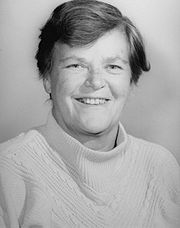Ailsa Land facts for kids
Quick facts for kids
Ailsa Land
|
|
|---|---|
 |
|
| Born |
Ailsa Horton Dicken
14 June 1927 West Bromwich, Staffordshire, England
|
| Died | 16 May 2021 (aged 93) |
| Education | Malvern Collegiate Institute |
| Alma mater | London School of Economics |
| Known for | Branch and bound algorithm |
| Spouse(s) | Frank Land |
| Scientific career | |
| Fields | Operational research |
| Institutions | London School of Economics |
Ailsa Horton Land (born Dicken) was a very smart professor. She was born on June 14, 1927, and passed away on May 16, 2021. She taught at the famous London School of Economics. Ailsa was the first woman professor of Operational Research in Britain. This field uses math and logic to solve real-world problems.
She is most famous for helping create the "branch and bound" algorithm. This is a special method used to solve difficult math problems. She worked on this with Alison Doig in 1960. Ailsa was married to Frank Land, who was also a professor at the LSE.
Contents
Ailsa's Early Life
Ailsa Dicken was born in West Bromwich, England, in 1927. She was the only daughter of Elizabeth and Harold Dicken. Her father worked in a sports business.
Ailsa loved science at school. She didn't like her local grammar school because it was too strict. So, her parents sent her to a small boarding school called Rocklands. This school was in Hastings, England. It had only about 50 students. Students there could learn at their own speed. They focused a lot on mathematics.
Moving to Canada During Wartime
When World War Two started, Ailsa's mother took her to Canada. They hoped to stay with relatives there. They left in April 1939. By September, Britain and Canada were at war with Germany. This meant Ailsa and her mother were stuck in Canada.
Ailsa's father stayed in England. He worked for the RAF (Royal Air Force) until the war ended. Ailsa and her mother settled in Toronto, Canada. Ailsa went to the Malvern Collegiate Institute for three years.
In 1943, Ailsa and her mother joined the Canadian Women's Army Corps. Ailsa was only 16, so she pretended to be 18 to join. By 1944, they both worked in offices in Ottawa. These offices were run by women. This allowed male soldiers to go fight in Europe. Ailsa and her mother later returned to the UK. Her father needed a dangerous operation, which he survived.
Ailsa's Education
In 1946, Ailsa started studying economics at the LSE. Because she had served in the army, she got a special grant. She won an award for her first-year economics paper. After graduating in 1950, she stayed at the LSE for her whole career.
Ailsa earned her PhD from the London School of Economics in 1956. Her special project was about how to transport coal. She figured out how to solve a big transport problem without a computer. She had to find the best routes when the costs were unknown.
Ailsa's Research Work
After finishing her studies, Ailsa became a research assistant at the LSE. She moved up through different roles. She became a lecturer, then a senior lecturer, and finally a professor. Her background in economics helped her a lot in her work.
The Branch and Bound Method
Ailsa is most famous for creating the "branch-and-bound" method. She developed this with Alison Doig. Their work was published in 1960. They worked on this project for British Petroleum. The goal was to make oil refinery operations better.
Ailsa and Alison didn't have computers at the time. But they created an algorithm (a set of steps) that could be used by computers later. Today, this method is very important. It helps solve many difficult optimization problems.
Other Important Research
Ailsa also worked on other complex math problems. She studied the "travelling salesman problem". This problem tries to find the shortest route for a salesman visiting many cities. She also helped develop computer tools.
In 1973, Ailsa published a book with Susan Powell. It was called Fortran Codes for Mathematical Programming. This book helped people use computers to solve math problems. She made her computer codes available for free. This helped many other researchers.
Ailsa's Teaching Career
During her time at the LSE, Ailsa helped start a special two-year course. It was for students learning about Operational Research. She also created math courses for university students.
Ailsa taught and guided many students. Some of her students became very successful around the world.
Awards and Special Honours
In 1994, Ailsa Land won the Harold Larnder prize. This award was from the Canadian Operational Research Society. It recognized her amazing work in operational research.
The London School of Economics also has a special award named after her. It's called the Ailsa Land Prize. It is given to students each year.
Ailsa's Personal Life
Ailsa met her future husband, Frank Land, at university. Frank had come to Britain in 1939 as a refugee. He was one of the people who helped create the Leo computer. This was one of the first computers used for business.
Ailsa and Frank married in 1953. They had three children: Frances, Richard, and Margi. She had her children while she was working on her PhD.
After she retired from teaching in 1987, Ailsa kept doing research. She said, "Now I'm retired I can do some research!" She and her husband moved to Devon in 2000. Ailsa Land passed away on May 16, 2021, when she was 93 years old.
Images for kids


